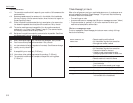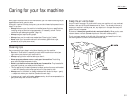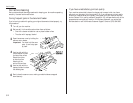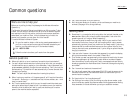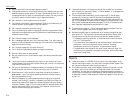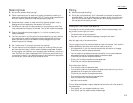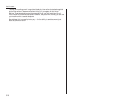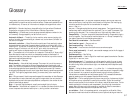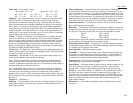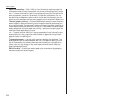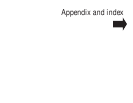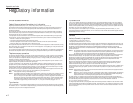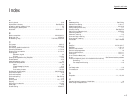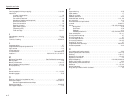
Just in case …
3.18
Effective printing width — The widest image that can be printed on a fax.
Effective scan width — The maximum width the scanner in a fax can scan
during transmission.
Facsimile (or fax) — A form of communication involving the scanning and decoding
of a document into electrical signals and transmitting of the document, over tele-
phone lines to another device which then reconstructs the signals to produce an exact
duplicate of the document. Also, a machine that performs such communication.
Fallback — Group 3 fax machines operate at the highest transmission speed possi-
ble on a given telephone line. Muratec systems offer automatic fallback; if line
quality drops during transmission, the fax machine will reduce speed to the fastest
possible level.
Fine resolution — 203
H
× 196
V
lpi. Also shown as
G
3
F
(“Group 3 fine”) on some
fax units.
Grayscale — Not a level of resolution, but a method of scanning and transmitting
halftone images. Fax machines with grayscale abilities interpret photographs in
levels of gray between white and black. The transmitting fax machine must have
grayscale ability to send a photographic image accurately, but the receiving
machine does not need it to print the image.
Group 3 — Refers to fax machines that use digital encoding. These units transmit
one page in less than one minute and produce resolution of 203 × 98, 203 × 196, or
203 × 392 lpi.
Halftone — See Grayscale.
Handshaking — A data interchange between telecommunications and/or
computer equipment that “introduces” two systems to each other. For example,
faxes use a handshaking protocol to identify the
ITU
-
T
group of each unit and to
begin fax communication.
Hub — See Relay broadcasting.
Hz (or Hertz) — A measure of frequency equal to one cycle per second. Used in the
specifications for a fax machine, it identifies the
AC
power the unit requires.
ITU
-
T
— International Telecommunications Union – Telecommunications Sector.
(Formerly known as
CCITT
, for Consultative Committee for International Telegraph
and Telephone.) A telecommunications forum for member countries of the United
Nations; its Study Group
XIV
established the primary groups for fax equipment, cov-
ering communication protocol and transmission. Muratec Group 3 fax machines
offer the fastest transmissions allowed by the
ITU
-
T
when communicating with other
Group 3 units.
ITU
-
T
Test Document 1 — Also called the Slerexe (“slehr-rehks”) letter; sometimes
erroneously called
ITU
-
T
Test Chart 1. An
ITU
-
T
standard document with a known
black density which fax makers often use in testing, and subsequently publicizing,
the transmission speeds of their fax machines.
ITU
-
TV
.29 and
V
.27 ter. — A standard set of communication procedures allowing
fax machines to talk to all other units adhering to those standards.
JBIG
— Joint Bi-level Image experts Group, the new
ITU
-
T
standard image data com-
pression method. As
JBIG
compresses the data more efficiently than
MMR
, it is
especially effective when transmitting halftone (grayscale) image document.
(Of course, the compression ratio may vary with the image data.)
Laser printing — A plain-paper printing system. Toner is attached to a charged
drum and an image is transferred onto plain paper through electrical currents, then
fused with heat and pressure to produce a dry, permanent printout.
LCD
— Liquid crystal display. Used on some Muratec units for status displays.
Leased line — See Private line.
Load number — A number assigned to telecommunications equipment used in
Canada; designed to help prevent overloading on a telephone circuit. See also
Ringer equivalence number.
Location
ID
— See Station
ID
.
lpi — Lines per inch. The way fax image resolution is measured. (For example, see
Normal resolution.)
MH
— Modified Huffman, the standard
ITU
-
T
Group 3 data compression method. A
one-dimensional coding scheme that compresses data in a horizontal direction only.
A feature of all Muratec fax machines,
MH
assures transmissions faster than one
page per minute when communicating with other Group 3 units, regardless of man-
ufacturer. See also
MSE
,
SMSE
.
Modem — Modulator-demodulator. A device that converts digital data, like infor-
mation from a fax machine, into an analog signal for transmission over ordinary
(analog) telephone lines. A modem is included in a fax machine and allows it to be
connected directly to a
PSTN
telephone line.
Monitor — A speaker in most Muratec fax machines which can allow one to hear
the dialing process. This is not a speakerphone, because it has no microphone for
speaking to the person being called; for regular two-way voice communication, one
must use the handset. See also On-hook dialing.
MSE
,
SMSE
— Muratec’s proprietary data compression methods, allowing a Muratec-
manufactured fax machine to transmit more quickly when communicating with
another Muratec-manufactured unit.
MSE
and
SMSE
are features on many Muratec
fax machines. See also
MH
.
Normal resolution — Shown as “norm”; 203
H
× 98
V
lpi. The default resolution
mode for all Muratec fax machines.
One-touch dialing — Allows the fax user to store frequently used fax numbers for
dialing with the touch of one key. See also Autodialing and Speed-dialing.
On-hook dialing — Dialing numbers by using the keypad on the fax unit without
lifting a handset. On most Muratec fax models, one can do this either silently or by
using the monitor. See also Monitor.
Original document size — The largest (or smallest) document that can be fed
safely through a fax machine.



